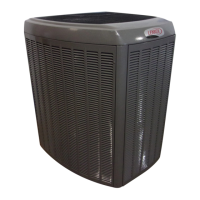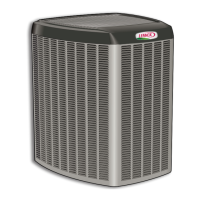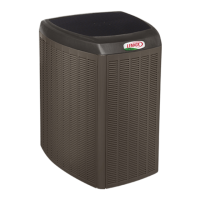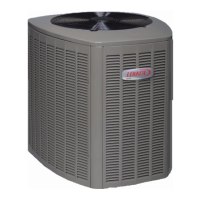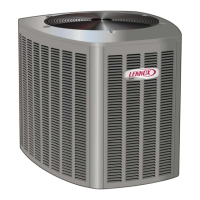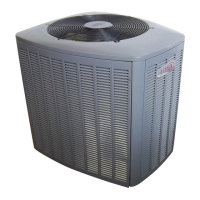Page 15
4−. If the board recognizes five temperature sensor range
faults during a single (Y1) compressor demand, it re-
verts to a lockout mode and displays the appropriate
code. The board detects open sensor or out-of-tem-
perature sensor range. This fault is detected by allow-
ing the unit to run for 90 seconds before checking sen-
sor resistance. If the sensor resistance is not within
range after 90 seconds, the board will count one fault.
After 5 faults, the board will lockout. (Code on board is
Discharge Sensor Fault and Lockout").
The discharge line sensor, which covers a range of 150°F
(65°C) to 350°F (176°C), is designed to mount on a ½" re-
frigerant discharge line.
NOTE − Within a single room thermostat demand, if
5−strikes occur, the board will lockout the unit. Defrost
board 24 volt power R" must be cycled OFF" or the
TEST" pins on board must be shorted between 1 to 2 sec-
onds to reset the board.
Second−Stage OperationIf the board receives a call for
second−stage compressor operation Y2" in heating or
cooling mode and the first-stage compressor output is ac-
tive, the second-stage compressor solenoid output will be
energized by the LSOM.
NOTE − The LSOM has a 5 second delay between Y2 being
powered and the solenoid energizing.
If first-stage compressor output is active in heating mode
and the outdoor ambient temperature is below the selected
compressor lock−in temperature, the second-stage com-
pressor solenoid output will be energized without the Y2"
room thermostat input. If the jumper is not connected to one
of the temperature selection pins on P3 (40, 45, 50, 55°F),
the default lock−in temperature of 40°F (4.5°C) will be used.
The board de−energizes the second-stage compressor so-
lenoid output immediately when the Y2" signal is removed
or the outdoor ambient temperature is 5°F above the se-
lected compressor lock−in temperature, or the first-stage
compressor output is de−energized for any reason.
Defrost Temperature Termination Shunt (Jumper)
PinsThe defrost board selections are: 50, 70, 90, and
100°F (10, 21, 32 and 38°C). The shunt termination pin is
factory set at 50°F (10°C). If the temperature shunt is not
installed, the default termination temperature is 90°F
(32°C).
Delay Mode
The defrost board has a field−selectable function to reduce
occasional sounds that may occur while the unit is cycling
in and out of the defrost mode. When a jumper is installed
on the DELAY pins, the compressor will be cycled off for 30
seconds going in and out of the defrost mode. Units are
shipped with jumper installed on DELAY pins.
NOTE − The 30 second off cycle is NOT functional when
jumpering the TEST pins.
Operational Description
The defrost control board has three basic operational
modes: normal, calibration, and defrost.
Normal ModeThe demand defrost board monitors the O
line, to determine the system operating mode (heat/cool),
outdoor ambient temperature, coil temperature (outdoor
coil) and compressor run time to determine when a defrost
cycle is required.
Calibration ModeThe board is considered uncalibrated
when power is applied to the board, after cool mode opera-
tion, or if the coil temperature exceeds the termination tem-
perature when it is in heat mode.
Calibration of the board occurs after a defrost cycle to en-
sure that there is no ice on the coil. During calibration, the
temperature of both the coil and the ambient sensor are
measured to establish the temperature differential which is
required to allow a defrost cycle. See figure 19 for calibra-
tion mode sequence.
Defrost ModeThe following paragraphs provide a de-
tailed description of the defrost system operation.
Detailed Defrost System Operation
Defrost CyclesThe demand defrost control board initi-
ates a defrost cycle based on either frost detection or time.
Frost DetectionIf the compressor runs longer than 34
minutes and the actual difference between the clear
coil and frosted coil temperatures exceeds the maxi-
mum difference allowed by the control, a defrost cycle
will be initiated.
TimeIf 6 hours of heating mode compressor run time has
elapsed since the last defrost cycle while the coil tem-
perature remains below 35°F (2°C), the demand de-
frost control will initiate a defrost cycle.
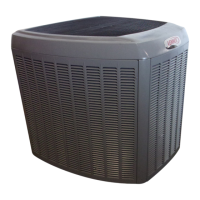
